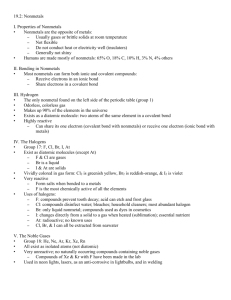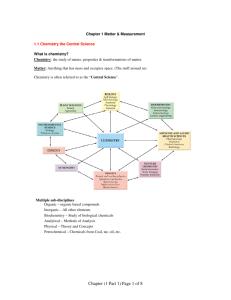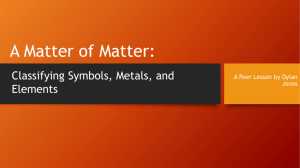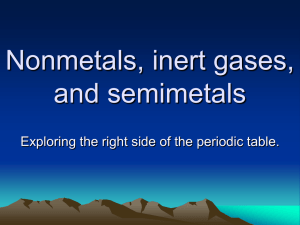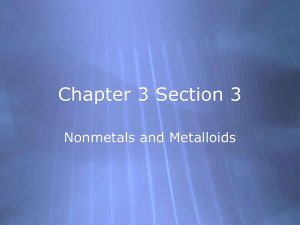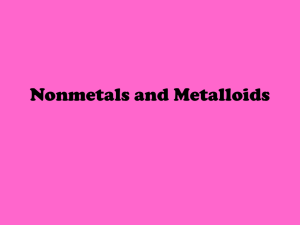The Periodic Table
advertisement
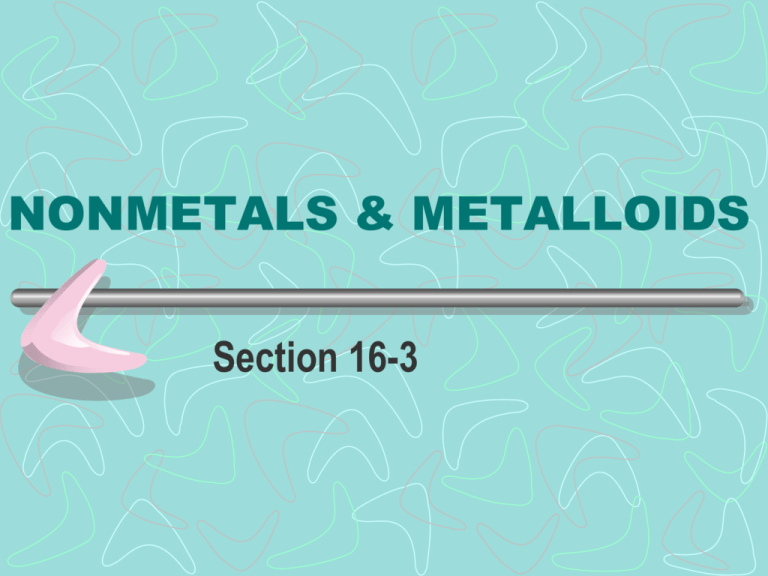
NONMETALS & METALLOIDS Section 16-3 Exploring Nonmetals Except for the noble (inert) gases, most families of nonmetals also contain metalloids and/or metals, so the families of nonmetals are not as similar in properties, as families of metals Properties of Nonmetals •Nonmetals make products with a wide variety of properties (fur, plants, plastics, liquids, gases) sulfur dull •Mostly gases at room temp. •Opposite physical properties of metals: soft, dull, poor brittle conductors, brittle (break easily), low densities. •Most nonmetals react (gain or NOT malleable or ductile, share electrons) to form Crumbles easily compounds (except nobles) Compounds of Nonmetals • Some compounds - Nonmetals gain electrons from metals (Na metal gives 1 veto Cl nonmetal to form the compound NaCl) • Other compounds – nonmetals share electrons with other nonmetals (CO or CO2) • Diatomics – nonmetals share electrons to form weak bonds with their “twin”; 7 elements: N2, O2, F2, Cl2, Br2, I2, & H2 Hydrogen is special! H 1 ve- • Hydrogen is a nonmetal and belongs to a family of its own. • Hydrogen is rarely found alone, it is usually combined with oxygen to form water • Hydrogen is a simple, reactive gas that will lose, gain, or share 1 valence electron. • Hydrogen was involved in the explosion of the Hindenberg. • Hydrogen is promising as an alternative fuel source for automobiles Carbon Family • • • • Elements in group 14, (one nonmetal, two metalloids, & two metals) Form compounds by losing, sharing, or gaining electrons Contains elements important to life and computers. Carbon is the basis for an entire branch of chemistry known as organic chemistry • Lead in household paints gave children lead poisoning • Silicon is a semiconductor, highly used in the computer industry. 4 veC Si Ge Sn Pb Nitrogen Family • Elements in group 15, (two nonmetals, two metalloids, & one metal) • Form compounds by sharing or gaining electrons • Nitrogen makes up ¾ of the earth’s atmosphere as N2 , but this form is not available to living things • Farmer use nitrogen rich soils for their crops, and we obtain the nitrogen we need from those plants • Nitrogen and phosphorus are both important in living things. • Phosphorus is used to make matches and flares 5 veN P As Sb Bi Oxygen Family 6 ve- • Elements in group 16 (three nonmetals, one metalloids, & one metal) • Oxygen is very reactive & forms compounds by sharing/gaining 2 ve• Oxygen is the most abundant element in the earth’s crust and second most abundant element in the atmosphere • Diatomic O2 is necessary for respiration and triatomic O3 called ozone protects us from radiation from the sun • Many things that stink, contain sulfur (rotten eggs, garlic, skunks, medicines) O S Se Te Po Halogens F Cl Br I At 7 ve- • Elements in group 17, very similar • Mostly diatomic elements, “twins” • Very reactive, volatile, nonmetals, but useful in compounds • Usually shares or gains 1 ve• Always found combined with other element in nature (NaCl) • Used disinfectants, to strengthen teeth, in nonstick cookware • Bromine is a liquid at room temp. The Noble Gases He Ne Ar Kr Xe Rn 8 or 0 ve(2 ve- if He) The Noble or Inert Gases • • • • Elements in group 18 VERY UNREACTIVE gases Have a full valence shell First found in small amounts, in the earth’s crust, in the late 1800’s • Used in lighted “neon” signs • Used in blimps to fix the Hindenberg problem

